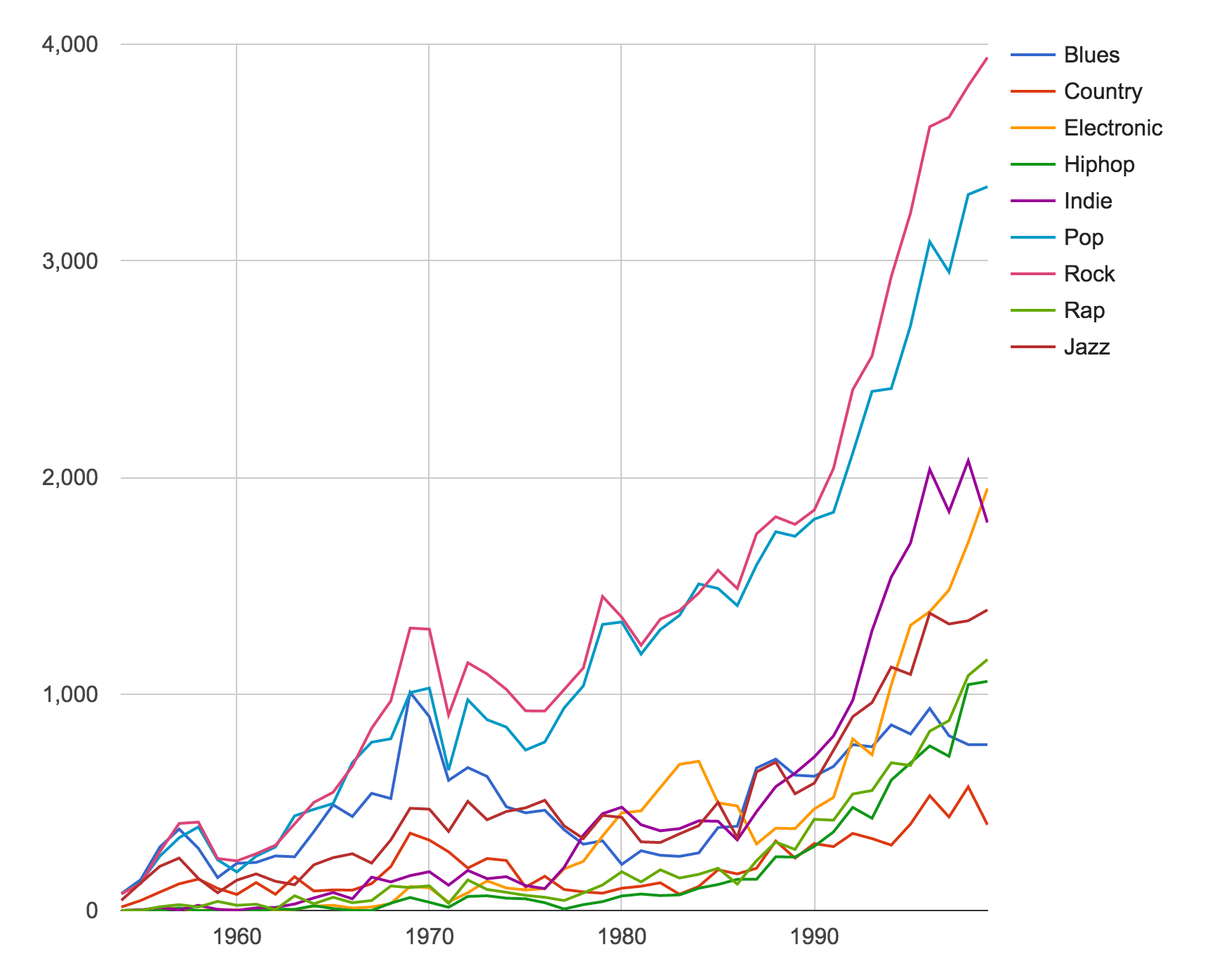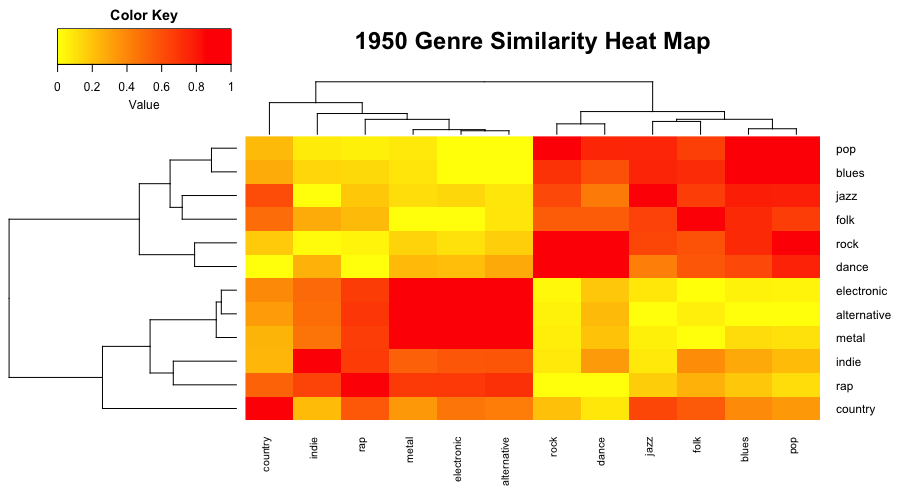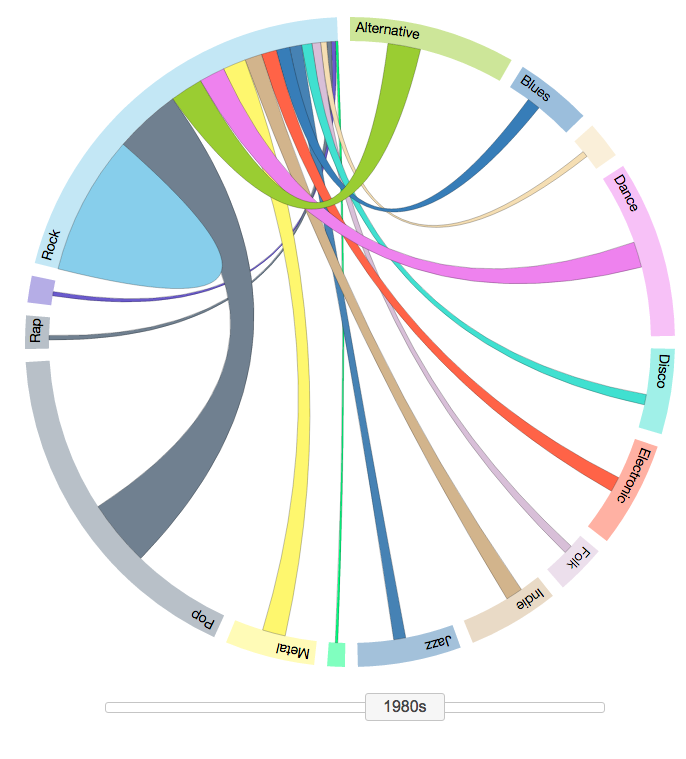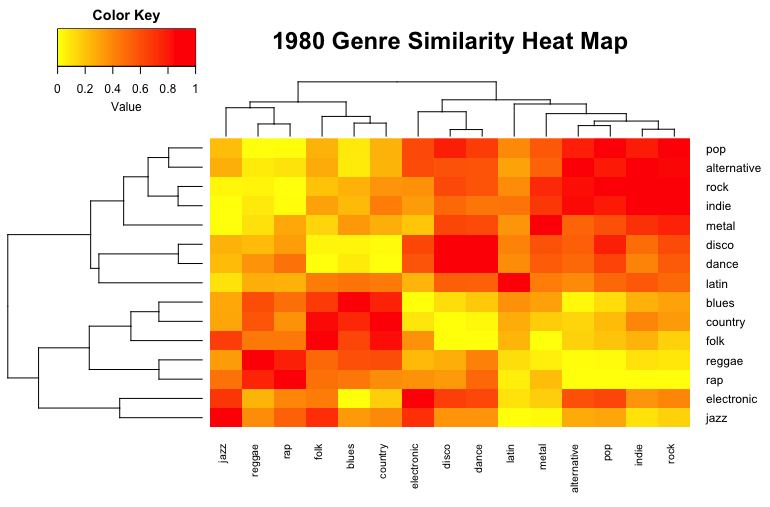Understanding Origins and Fusion of Music Genres
Introduction
In this guided narrative, we tell a story about the evolution of music genres over the decades. We use a series of interactive visualizations to illustrate how various genres emerged and coexisted over time. Specifically, we ask the following questions:
- How have different genres emerged and died over time?
- How has the compatibility of different fusion genres changed over time?
- Can we infer why two genres are compatible?
Before we begin, we will introduce the concept of fusion music genres, which are are fusions of various historical genres. People have been experimenting with combining instruments for centuries - or even millennia. Some combinations of instruments that we are familiar with today evolved over hundreds of years. Others were the result of necessity, or an accident, or a crazy idea at the spur of the moment.
In our exploration, we will be looking at how these fusion genres have evolved over time. This is important because understanding different fusion genres is complex when you have so many different types of music. Our visualizations could be used to study the history of music and identify which fusion genres were really successful. They could also tell us which genres were compatible in the past, providing musicians with valuable insights to bring back lost fusion genres.
About the Dataset
We use the Million Song Dataset from Columbia University's LAB ROSA. It contains a collection of audio features and metadata for a million contemporary popular music tracks. For more details on the dataset, see data quality.
After processing the data, we obtain a table for each decade showing the number of shared (cross-tagged) songs between genres. Here is the shared songs table for the 1990s. It says that, for example, there were 800 songs that were tagged as both Alternative and Blues.
| Genre | Alternative | Blues | Country | Dance | Disco | Electronic | Folk | Indie | Jazz | Latin | Metal | Pop | Rap | Reggae | Rock | |
|---|---|---|---|---|---|---|---|---|---|---|---|---|---|---|---|---|
| 0 | alternative | 11821 | 800 | 547 | 1955 | 452 | 2337 | 1463 | 5178 | 1291 | 255 | 2220 | 6092 | 1014 | 268 | 9967 |
| 1 | blues | 800 | 6194 | 472 | 615 | 175 | 251 | 566 | 491 | 1472 | 62 | 299 | 1640 | 375 | 67 | 2737 |
| 2 | country | 547 | 472 | 4315 | 354 | 62 | 97 | 838 | 449 | 196 | 41 | 87 | 996 | 82 | 24 | 1595 |
| 3 | dance | 1955 | 615 | 354 | 8229 | 1140 | 3430 | 463 | 1039 | 1595 | 397 | 581 | 4152 | 848 | 601 | 3463 |
| 4 | disco | 452 | 175 | 62 | 1140 | 2030 | 762 | 126 | 285 | 486 | 85 | 155 | 1221 | 189 | 45 | 916 |
| 5 | electronic | 2337 | 251 | 97 | 3430 | 762 | 8741 | 426 | 1290 | 2116 | 175 | 764 | 3144 | 560 | 178 | 3229 |
| 6 | folk | 1463 | 566 | 838 | 463 | 126 | 426 | 4927 | 1172 | 565 | 194 | 601 | 1796 | 177 | 70 | 2729 |
| 7 | indie | 5178 | 491 | 449 | 1039 | 285 | 1290 | 1172 | 7884 | 706 | 102 | 735 | 4611 | 528 | 138 | 6347 |
| 8 | jazz | 1291 | 1472 | 196 | 1595 | 486 | 2116 | 565 | 706 | 10519 | 443 | 471 | 2244 | 783 | 166 | 2494 |
| 9 | latin | 255 | 62 | 41 | 397 | 85 | 175 | 194 | 102 | 443 | 2038 | 108 | 827 | 120 | 105 | 829 |
| 10 | metal | 2220 | 299 | 87 | 581 | 155 | 764 | 601 | 735 | 471 | 108 | 9941 | 1304 | 602 | 92 | 5451 |
| 11 | pop | 6092 | 1640 | 996 | 4152 | 1221 | 3144 | 1796 | 4611 | 2244 | 827 | 1304 | 18551 | 1220 | 411 | 11167 |
| 12 | rap | 1014 | 375 | 82 | 848 | 189 | 560 | 177 | 528 | 783 | 120 | 602 | 1220 | 4283 | 214 | 1502 |
| 13 | reggae | 268 | 67 | 24 | 601 | 45 | 178 | 70 | 138 | 166 | 105 | 92 | 411 | 214 | 2196 | 888 |
| 14 | rock | 9967 | 2737 | 1595 | 3463 | 916 | 3229 | 2729 | 6347 | 2494 | 829 | 5451 | 11167 | 1502 | 888 | 31295 |
Visualization 1: Emergence and Death of Genres
Question: How have different genres emerged and died over time?Number of Popular Songs vs. Year Per Genre

From 1950s to 1980s, most of the genres had a similar gradual rise. An exception is Blues, which declined in the 80s. Electronic music started becoming very popular in the 80s.
1990s (and subsequently 2000s) saw a huge increase in popularity for most of the genres, especially, rock, pop, electronic and indie. This is the decade when music sharing became popular (rise of MP3 and digital downloads) and independent labels grew.
Visualization 2: Compatibility of Genres
Question: How has the compatibility of different fusion genres changed over time? (based on number of shared songs)Using this interactive chord diagram, we can examine the similarities between the fusion genres over the decades. The thickness of each chord (connection between two genres) is proportional to the number of shared songs between the genres, conveying the similarity of those genres.
1950s – The Years of Rock n Roll
- Pop, Rock, Blues, Jazz, Country and Dance are the major genres in this decade.
- Rock Dance, Pop Dance, Pop Rock are famous. These combination of genre all come under Rock n Roll.
- Rock n Roll also had components of Blues. Hence Blue Rock was also famous.
1960s – Experimentation & New Genres
- Rock and Pop are the most popular genres in 1960s followed by Blues, Folk, Jazz , Country and Dance.
- Alternative, Rap , Metal, Indie and Dance have just started to emerge.
- Latin music dies
- Alternative Rock which basically represented experimentation on Rock is just starting to emerge.
- Jazz Rock has emerged which is a very interesting genre as Jazz and Rock are quite different on acoustics.
1970s – Embracing New Genres
- Suddenly we see Reggae become popular because of Bob Marley.
- Electronic and Disco start to become popular.
- Different forms of rock, alternative rock and metal start gaining more popularity.
- Electronic diversifies into Electronic Pop and Electronic Rock.
1980s – Decline of Old Genres
- Folk music start to die and blues and jazz becomes less popular.
- Reggae dies with Bob Marley
- Electronic music diversifies into Electronic Dance besides rock and pop which is named as EDM in short.
1990s – Rise of Indie Artists
- Rap gains popularity.
- Disco declines, dance and electronic starts gaining huge popularity.
- Indie bands rise at a huge rate as there is no need of record labels to sell music now as everyone has direct access to music for free or cheap via internet.
- Indie rocks becomes more popular
2000s – Music Sharing Becomes Popular
- Indie bands continue to rise even more because music sharing becomes popular.
- Rap, Metal, electronic and dance continues to gain popularity.
- Blues continue to die.
- 1990s-2000s had the same trend in compatibility. The fusion genres that emerged before continues to rise.
Visualization 3: Compatibility of Genres
Question: How has the compatibility of different fusion genres changed over time? (based on correlation of acoustics)Similarly, we can use heatmaps to gauge the similarity between genres. However, instead of using the number of shared songs as a proxy for similarity, we will now use correlation between four acoustic features (average timbre, tempo, loudness, duration) to measure similarity between genres over the six decades. Red squares indicate high correlation in acoustics, conveying similarity between the genres.

Analysis
Question: Can we infer why two genres are compatible?When we compare the heatmap and chord diagram for a single decade, we can gain some valuable insights. For example, consider the two visualizations for the 1980s.


From the chord diagram, we see that rock is most compatible with pop, dance, metal, and indie (wide chords between genres). Similarly, the heatmap tells us that rock is most compatible with indie, pop, metal, and alternative (dark red values). These findings from the heatmap correlates with those from the chord diagram. This supports the hypothesis that these genres are not only most compatible in terms of the number of shared songs, but also in their acoustics.
There are however, some contradictory findings as well. From the heatmap, we can see that rock is least similar in terms of acoustics to reggae, folk, jazz, rap, and blues. However, the chord diagram does not indicate low compatibility with some of these genres. For example, folk has high proportion of shared songs with rock. These contradictions might arise due to several reasons:
- We may be missing features in our analysis to gauge similarity between genres. For instance, we don't have song lyrics.
- Different tags for genres – e.g. folk is also sometimes called world music. We might have missed several such data points because we used regex to group genres.
- Mislabeling of genres by users
Conclusion
Some of our key takeaways from this analysis are:
- The origin of different genres and their fusion with one another are coherent with historical and societal factors such as the emergence of popular artists and advancements in technology.
- The number of shared songs between genres is coherent with acoustic similarity in most cases.
- Genres have become more diversified and once-niche genres (like Electronic) have rapidly gained popularity in recent decades.
For further investigation of this data, we would like to add acoustic similarity in the chord diagram instead of using a separate heatmap by changing the transparency of chord color based on acoustic similarity.